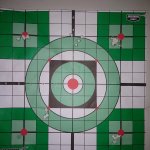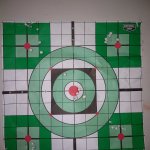kilotanker22
New member
So I have been thinking a lot about this lately while trying to squeeze the most out of my rifles and ammunition while also trying to hone my own skills and constantly work on fundamentals.
I have noticed a few things. Now I don't have the tools, or mathematical skills to measure any of this in a scientific way. However I have seen several Instances where increasing velocity or decreasing velocity actually gave me horizontal dispersion instead of vertical. I have also noticed that with any of my 24 inch barrels, even though some are much faster with the same load than others. When I adjust the powder charge, or the seating depth in an attempt to compensate for the pressure difference. I have noticed that about the time that I get back to the nominal velocity for that load, all of the 24" barrel rifles shoot considerably better.
Also I have noted in my Savage Tactical Rifle that with any 140 class bullet with either H-4350 or Reloder 16 At 2800 fps shoots right between .7-.9 moa on average. However when my Magnetospeed Chronograph is hanging off of the barrel two things happen.
1: Group sizes are literally cut in half! With the same loads. I have tested this theory over hundreds of groups in several different rifles. With each rifle and load the results have been very similar.
2: Point of impact shifts 4-5 moa high and horizontal dispersion is virtually non existent. In all of the rifles with those loads, without the Chronograph. Vertical dispersion is very low while the largest dispersions are always horizontal. With the Chronograph, POI shifts high while eliminating the horizontal dispersion.
I have trouble finding any other explanation than this being due to barrel harmonics and the added weight of the chronograph reducing variation in the antinode moments of the barrel at the muzzle. There is less variation at the muzzle at the moment the bullets clears the barrel therefore I see less variation on the target.
To continue testing this theory I ordered a muzzle brake to use on these rifles. I chose a brake that weighs roughly the same as my chronograph. It will be interesting to see if I have the same or similar results. I plan to use the data already collected as a control.
Also worth noting is that the barrel that shows the least amount of POI shift when the chronograph is attached is also the heaviest profile barrel. Also the barrel that shows the largest POI shift is the lightest profile barrel. I have found the same result when measuring the horizontal dispersions of each rifle with the same loads. When the chronograph is not attached.
What is your take? I look forward to hearing from Bart B and Unclenick on this. Is what I am finding a coincidence? Or is there maybe something there?
My Brake will be delivered tomorrow, so I plan to try to test the first rifle on Friday.
I have noticed a few things. Now I don't have the tools, or mathematical skills to measure any of this in a scientific way. However I have seen several Instances where increasing velocity or decreasing velocity actually gave me horizontal dispersion instead of vertical. I have also noticed that with any of my 24 inch barrels, even though some are much faster with the same load than others. When I adjust the powder charge, or the seating depth in an attempt to compensate for the pressure difference. I have noticed that about the time that I get back to the nominal velocity for that load, all of the 24" barrel rifles shoot considerably better.
Also I have noted in my Savage Tactical Rifle that with any 140 class bullet with either H-4350 or Reloder 16 At 2800 fps shoots right between .7-.9 moa on average. However when my Magnetospeed Chronograph is hanging off of the barrel two things happen.
1: Group sizes are literally cut in half! With the same loads. I have tested this theory over hundreds of groups in several different rifles. With each rifle and load the results have been very similar.
2: Point of impact shifts 4-5 moa high and horizontal dispersion is virtually non existent. In all of the rifles with those loads, without the Chronograph. Vertical dispersion is very low while the largest dispersions are always horizontal. With the Chronograph, POI shifts high while eliminating the horizontal dispersion.
I have trouble finding any other explanation than this being due to barrel harmonics and the added weight of the chronograph reducing variation in the antinode moments of the barrel at the muzzle. There is less variation at the muzzle at the moment the bullets clears the barrel therefore I see less variation on the target.
To continue testing this theory I ordered a muzzle brake to use on these rifles. I chose a brake that weighs roughly the same as my chronograph. It will be interesting to see if I have the same or similar results. I plan to use the data already collected as a control.
Also worth noting is that the barrel that shows the least amount of POI shift when the chronograph is attached is also the heaviest profile barrel. Also the barrel that shows the largest POI shift is the lightest profile barrel. I have found the same result when measuring the horizontal dispersions of each rifle with the same loads. When the chronograph is not attached.
What is your take? I look forward to hearing from Bart B and Unclenick on this. Is what I am finding a coincidence? Or is there maybe something there?
My Brake will be delivered tomorrow, so I plan to try to test the first rifle on Friday.
Last edited:


